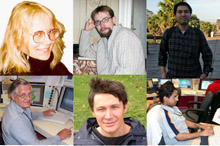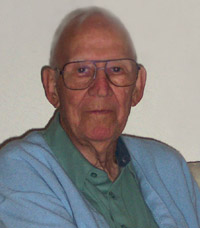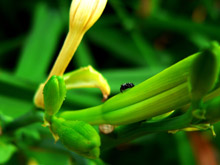 | Thursday, September 14, 2006 |
|
Thursday, September 14
Friday, September 15
Saturday, September 16 Click here for a full calendar with links to additional information. |
|
Extended Forecast |
Secon Level 3 |
|
Thursday, September 14 -Santa Fe Black Bean -Sloppy Joe -Stuffed Peppers -Sauteed Liver & Onions -Baked Ham & Swiss on a Ciabatta Roll -Assorted Slice Pizza -Crispy Fried Chicken Ranch Salad |
|
Thursday, September 14 Dinner -Puree Gloria -Grilled Jumbo Shrimp -Angel Hair Pasta Diavolo -Sautéed Spinach w/Bacon -Profiteroles Wednesday, September 20 Lunch -Pastelon de Pollo -Confetti Salad -Tropical Fruit Platter w/Lime Chez Leon Menu Call x4598 to make your reservation. |
| Fermilab Today is online at: http://www.fnal.gov/today/ Send comments and suggestions to today@fnal.gov Fermilab Today archive Hurricane Relief Page Fermilab Today PDF Version Fermilab Result of the Week archive Fermilab Safety Tip of the Week archive Linear Collider News archive Fermilab Today classifieds Subscribe/Unsubscribe to |
|
|
|
ESO Press Release September 12, 2006: A "Genetic Study" of the Galaxy Looking in detail at the composition of stars with ESO's VLT, astronomers are providing a fresh look at the history of our home galaxy, the Milky Way. They reveal that the central part of our Galaxy formed not only very quickly but also independently of the rest. The Milky Way is a spiral galaxy, having pinwheel-shaped arms of gas, dust, and stars lying in a flattened disc, and extending directly out from a spherical nucleus of stars in the central region. The spherical nucleus is called a bulge, because it bulges out from the disc. While the disc of our Galaxy is made up of stars of all ages, the bulge contains old stars dating from the time the galaxy formed, more than 10 billion years ago. Thus, studying the bulge allows astronomers to know more about how our Galaxy formed. To do this, an international team of astronomers [2] analysed in detail the chemical composition of 50 giant stars in four different areas of the sky towards the Galactic bulge. They made use of the FLAMES/UVES spectrograph on ESO's Very Large Telescope to obtain high-resolution spectra.
The chemical composition of stars carries the signature of the enrichment processes undergone by the interstellar matter up to the moment of their formation. It depends on the previous history of star formation and can thus be used to infer whether there is a 'genetic link' between different stellar groups. In particular, comparison between the abundance of oxygen and iron in stars is very illustrative. Oxygen is predominantly produced in the explosion of massive, short-lived stars (so-called Type II supernovae), while iron instead originates mostly in Type Ia supernovae [3], which can take much longer to develop. Comparing oxygen with iron abundances therefore gives insight on the star birth rate in the Milky Way's past.
|
| Why antimatter does not matter | ||
| ||
|
Matter and antimatter behave in slightly different ways. This phenomenon, known as CP violation (CPV), is not often discussed in everyday life, but it is essential for explaining why the world around us is made of matter and contains almost no antimatter. Understanding the sources of CPV will shed light on the basic principles governing the universe.
The DZero experiment has recently reported several pioneering measurements aimed at finding evidence for CPV in Bs mesons, which are composed of beauty and strange quarks. In a perfectly symmetric world, the properties of the decays of Bs and anti-Bs mesons would be the same. DZero probes CPV by analyzing the time evolution of the relative orientation of particles emanating from a large sample of Bs mesons decaying into a pair of lighter mesons, the J/Ψ and Φ. In addition, DZero has searched for CPV by looking for a difference in the rates at which Bs mesons decay to positive or negative muons. The combination of these measurements is presented in terms of a parameter "δ φS", which quantifies the amount of CPV observed. The above figure shows possible values of δ φS on the horizontal axis and possible values of another parameter related to the Bs system--the decay rate difference between two closely related incarnations of the Bs--on the vertical axis. The DZero measurements of these two parameters are shown as the red star with the corresponding uncertainty shown as the red contour. The value predicted by the Standard Model is shown as the black vertical line. This is the first time an experiment has directly constrained CPV in the Bs system and has shown that it is not a new source of anomalously large CPV. Profiting from the excellent recent performance of the Tevatron, DZero plans to update these pioneering measurements with larger datasets and greater sensitivity in the near future.
| ||
 |
||
Above: The following members of the DZero collaboration contributed to this analysis: (top row, from left) Daria Zieminska, Kostya Holubyev, Kin Yip, (bottom row, from left) Bruce Hoeneisen, Guennadi Borissov, and Avdhesh Chandra. Below: This CP violation measurement with the DZero detector is possible because of the excellent muon acceptance of the DZero detector and the periodic polarity switching of both the DZero superconducting solenoid and muon toroid magnet systems. Our DZero colleague Rich Smith, who died on 7/11/2006, is shown here working on the field measuring apparatus in the solenoid bore during July of 1998. Rich was deeply involved in all aspects of the DZero solenoid from design to operation.
 Result of the Week Archive
|
|
|
September 11 - 13 - Two stores provided 45 hours and 36 minutes of luminosity - Recycler loses antiprotons due to power supply trip - NuMI resumes taking beam - TeV sector E48 separator spark Read the Current Accelerator Update Read the Early Bird Report View the Tevatron Luminosity Charts |
|
NALWO Picnic tomorrow NALWO will hold a fall picnic on September 15, from 5:30 to 8:00 p.m. just outside the Kuhn Barn. Meet friendly lab families and join us for an evening of supper and games. Children are welcome; each family gets a Fermilab Frisbee. Please bring food to grill, and a dish to share among 8 people, such as a casserole, salad or side dish. NALWO will provide charcoal grills, plates and cutlery, soft drinks and desserts. For additional information, contact the Housing Office, 630/840-3777 or housing@fnal.gov; Rose Moore, 630/208-9309 or Christiane Albrow, 630/717-8906.
English Country Dancing |



